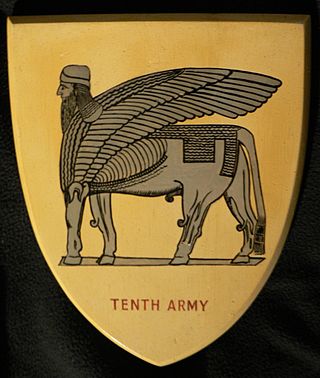
The 101st Airborne Division is a light infantry division of the United States Army that specializes in air assault operations. It can plan, coordinate, and execute multiple battalion-size air assault operations to seize terrain. These operations can be conducted by mobile teams covering large distances, fighting behind enemy lines, and working in austere environments with limited or degraded infrastructure. Its unique battlefield mobility and high level of training have kept it in the vanguard of U.S. land combat forces in recent conflicts: for example, foreign internal defense and counterterrorism operations in Iraq, in Afghanistan in 2015–2016, and in Syria, as part of Operation Inherent Resolve in 2018–2021.

The 82nd Airborne Division is an airborne infantry division of the United States Army specializing in parachute assault operations into denied areas with a U.S. Department of Defense requirement to "respond to crisis contingencies anywhere in the world within 18 hours". Based at Fort Bragg, North Carolina, the 82nd Airborne Division is part of the XVIII Airborne Corps. The 82nd Airborne Division is the U.S. Army's most strategically mobile division.

The XVIII Airborne Corps is a corps of the United States Army that has been in existence since 1942 and saw extensive service during World War II. The corps is designed for rapid deployment anywhere in the world and is referred to as "America's Contingency Corps." Its headquarters are at Fort Bragg, North Carolina.

The Islamic Republic of Iran Army Ground Forces, acronymed NEZAJA are the ground forces of the Islamic Republic of Iran Army.

The Tenth Army was a field army of the British Army during the Second World War created in Iraq and formed from the major part of "Paiforce". It was active in 1942 and 1943, and then disbanded.

The Iraqi Ground Forces, or the Iraqi Army, is the ground force component of the Iraqi Armed Forces. It was known as the Royal Iraqi Army up until the coup of July 1958.

The Turkish Third Army is a field army of the Turkish Army and is the country's largest army.
Iraqforce was a British and Commonwealth formation that came together in the Kingdom of Iraq. The formation fought in the Middle East during World War II.

The Persia and Iraq Command was a command of the British Army established during the Second World War in September 1942 in Baghdad. Its primary role was to secure from land and air attack the oilfields and oil installations in Persia and Iraq. Its further role was to ensure the transport of supplies from Persian Gulf ports through Iraq and Persia to the Soviet Union.
These are the orders of battle of the Iraqi and Iranian armies for the start of the Iran–Iraq War in 1980. The data is drawn from the Air Combat Information Group's Arabian Peninsula and Persian Gulf Database.

The 1st Division (IFF) is a motorized infantry division of the Iraqi Army headquartered in Camp Fallujah.

The 9th Armoured Division is a formation of the Iraqi Army, originally formed probably around 1975, but disbanded in 1982. It was reformed after 2004.

The 8th Division is a division of the Iraqi Army. Before being reformed after 2004 it was part of the previous Iraqi Army. Just before the Iran–Iraq War it was located at Erbil as part of the 1st Corps. The 8th Division is composed of former Iraqi National Guard units, some of which were formed as early as 2004, but the division headquarters did not assume control of its area of operations until January 2006.

The Eastern Command is one of the six operational commands of the Indian Army. It is headquartered in Fort William in the city of Kolkata in the state of West Bengal. The Eastern Command was formed on 1 November 1920. The Command is commanded by a three-star rank officer with the title General Officer Commanding-in-Chief (GOC-in-C).

The 10th Division is a formation of the Iraqi Army that was dissolved in 2003, but reinstated in 2007.
Operation Dezful was fought in early stage of the Iran–Iraq War on 15 October 1980 as Iranian tank brigades from the 16th Qazvin, 77th Khorasan, and 92nd Khuzestan armoured divisions attacked Iraqi positions. The Iranian Army's aim was to stop Iraqis progress in Iranian territories and to push them back. However, Iraqi forces counterattacked from the flanks, and repulsed the Iranian forces. The Iranian failure was blamed on poor decision making, the purge of army commanders due to their participation in Nojeh coup plot, and underestimating fire power of Iraqi forces and they were forced to retreat to the eastern shores of Karkheh River west of Dezful.

The 1st Corps was a corps of the Iraqi Army, established before the Iran–Iraq War. It was located in Kurdistan Region
The 2nd Corps was a corps of the Iraqi Army, established before the Iran-Iraq War. It was initially located in the central regions of Iraq.
The Ninewa Operational Command (NOC) is a interagency command of the Iraqi Armed Forces and Iraqi Ministry of the Interior. Up until 2014 it had its headquarters in Mosul. It holds responsibility for all anti-ISIS operations in Ninewa Governorate.
The Basra Operations Command is a organisation of the Government of Iraq which coordinates both Ministry of Defence and Ministry of Interior security forces in Basra Governorate. It was established in August 2007, and quickly became involved in the Battle of Basra (2008) against the Shia Jaysh al-Mahdī militia in Basra. Headquarters is in Basrah.












